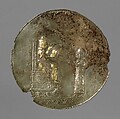Medallion with a seated deity and a male worshiper
Not on view
The kings of Urartu ruled what is now eastern Turkey, Armenia, and northwestern Iran from their capital at Tushpa (modern Van, Turkey) during the early first millennium B.C. Urartian fortresses, strategically placed on high rock outcrops, dominated the landscape of their territories and protected the kingdom from their rivals, the Assyrians. Despite confrontations with the Assyrians, the Urartians also borrowed many images and iconographic elements from Assyrian art and made them their own.
This silver medallion, partially covered with gold foil, shows a deity seated on a throne supported by lions facing a male worshiper whose arms are raised in supplication or respect. Both the deity with horned headdress on a throne supported by animals and the worshiper figure are common Assyrian motifs; the long fringed garments are widespread in the ancient Near East. Here, the scene is set on a ground line of paired zigzag lines between pairs of parallel horizontal lines, a decorative pattern characteristic of Urartian medallions. Such medallions in silver, gold, and bronze are thought to be insignias of rank and authority and have been found at sites in both Armenia and Turkey.
Due to rights restrictions, this image cannot be enlarged, viewed at full screen, or downloaded.

